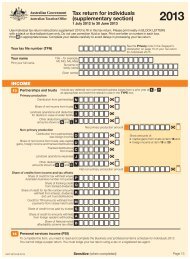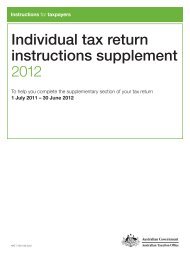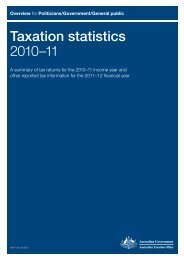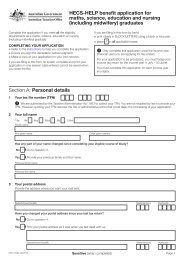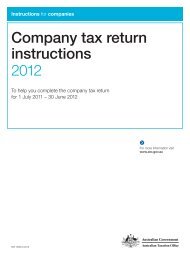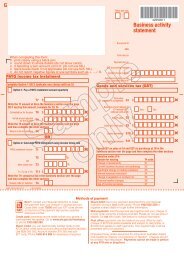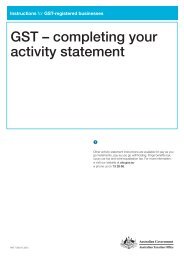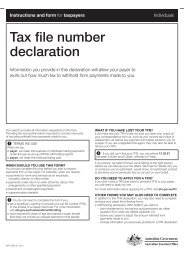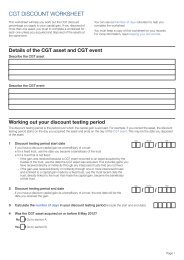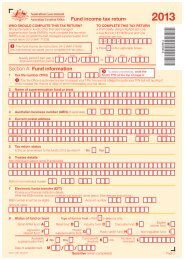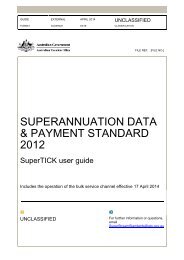Guide to depreciating assets 2013 - Australian Taxation Office
Guide to depreciating assets 2013 - Australian Taxation Office
Guide to depreciating assets 2013 - Australian Taxation Office
You also want an ePaper? Increase the reach of your titles
YUMPU automatically turns print PDFs into web optimized ePapers that Google loves.
Example: the amount of the deduction for thegeneral small business pool is less than $6,500 in thestart yearHans’ Florist is a small business entity that buys a $7,000second hand van in the 2012-13 income year for flowerdeliveries. The van is only used for business purposes.In the same year, Hans’ Florist sells a large displayrefrigera<strong>to</strong>r for $1,700. The opening pool balance for theyear was $1,000. Hans’ Florist works out the deductionfor the general small business pool as follows:$1,000 + $7,000 = $8,000 - $1,700 = $6,300Hans’ Florist can claim a deduction for the general smallbusiness pool of $6,300, writing off the entire value of thepool. The deductions for the mo<strong>to</strong>r vehicle are included inthe $6,300 deduction for the general small business pooland no further deductions are available for the van.Assets for which deductions are claimedunder the UCAFor some <strong>depreciating</strong> <strong>assets</strong>, deductions must beclaimed under the UCA rather than under the simplifieddepreciation rules:n <strong>assets</strong> that are leased out, or are expected <strong>to</strong> be leased out,for more than 50% of the time on a <strong>depreciating</strong> asset lease*n <strong>assets</strong> allocated <strong>to</strong> a low-value or a common-rate poolbefore you started <strong>to</strong> use the simplified depreciation rules(those <strong>assets</strong> must remain in the pool and deductions mustbe claimed under the UCA)n horticultural plants, andn in-house software where the development expenditure isallocated <strong>to</strong> a software development pool; see Softwaredevelopment pools on page 25.* This does not apply <strong>to</strong> <strong>depreciating</strong> <strong>assets</strong> subject <strong>to</strong> hire purchaseagreements, or short-term hire agreements on an intermittent hourly, daily,weekly or monthly basis where there is no substantial continuity of hiring.Depreciating <strong>assets</strong> used in rental properties are generally excluded fromthe simplified depreciation rules on the basis that they are subject <strong>to</strong> a<strong>depreciating</strong> asset lease.Capital expenditure deductible under the UCAAs the simplified depreciation rules apply only <strong>to</strong> <strong>depreciating</strong><strong>assets</strong>, certain capital expenditure incurred by a smallbusiness entity that does not form part of the cost of a<strong>depreciating</strong> asset may be deducted under the UCA rulesfor deducting capital expenditure.This includes capital expenditure on certain business relatedcosts and amounts directly connected with a project; seeCapital expenditure deductible under the UCA on page 28.In-house softwareUnder the UCA, you can choose <strong>to</strong> allocate <strong>to</strong> a softwaredevelopment pool expenditure you incur in developing (orhaving another entity develop) in-house software you intend<strong>to</strong> use solely for a taxable purpose. Once you allocateexpenditure on such software <strong>to</strong> a pool, you must allocateall such expenditure incurred thereafter (in that year or ina later year) <strong>to</strong> a pool; see Software development poolson page 25.If you have allocated such expenditure <strong>to</strong> a softwaredevelopment pool either before or since using the simplifieddepreciation rules, you must continue <strong>to</strong> allocate suchexpenditure <strong>to</strong> a software development pool and calculateyour deductions under the UCA.If you:n have not previously allocated such expenditure <strong>to</strong> a softwaredevelopment pool and you choose not <strong>to</strong> do so this year, orn incur the expenditure in developing in-house software thatyou do not intend using solely for a taxable purpose,then you can capitalise it in<strong>to</strong> the cost of the unit of softwaredeveloped and claim deductions for the unit of in-housesoftware under the simplified depreciation rules when youstart <strong>to</strong> use it (or install it ready for use) for a taxable purpose.Its decline in value can then be worked out using an effectivelife of four years (if you started <strong>to</strong> hold the in-house softwareunder a contract entered in<strong>to</strong> after 7.30 PM AEST on 13 May2008 or otherwise started <strong>to</strong> hold it after that day and theprime cost method.Deductions for in-house software acquired off the shelf bya small business entity for use in their business are availableunder the simplified depreciation rules. For example, suchan item costing less than $6,500 will qualify for an outrightdeduction.Primary producersA small business entity can choose <strong>to</strong> claim deductionsunder either the simplified depreciation rules or the UCA forcertain <strong>depreciating</strong> <strong>assets</strong> used in the course of carrying ona business of primary production. The choice is available forwater facilities and for <strong>depreciating</strong> <strong>assets</strong> relating <strong>to</strong> landcareoperations, electricity connections and phone lines; seepages 28–29.You can choose <strong>to</strong> claim your deductions under the simplifieddepreciation rules or the UCA for each <strong>depreciating</strong> asset.Once you have made the choice, it cannot be changed.RECORD KEEPINGYou must keep the following information for a<strong>depreciating</strong> asset:n the first and second elements of costn the opening adjustable value for the income yearn any adjustments made <strong>to</strong> cost or adjustable valuen the date you started holding the asset and its start timen the rate or effective life used <strong>to</strong> work out the decline in valuen the method used <strong>to</strong> work out the decline in valuen the amount of your deduction for the decline in value andany reduction for use of the asset for a non-taxable purposen the adjustable value at the end of the income yearn any recoupment of cost you have included in assessableincome, andn if a balancing adjustment event occurs for the assetduring the year, the date of the balancing adjustmentevent, termination value, adjustable value at that time,the balancing adjustment amount, any reduction of thebalancing adjustment amount and details of any rolloveror balancing adjustment relief.34 a<strong>to</strong>.gov.au GUIDE TO DEPRECIATING ASSETS <strong>2013</strong>



